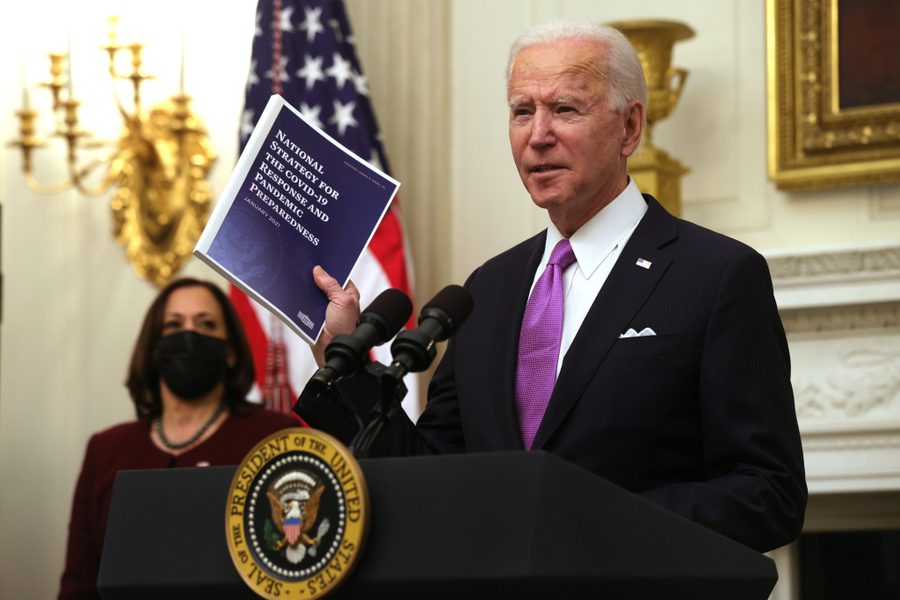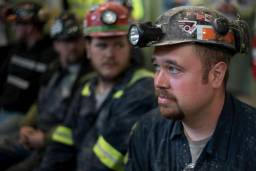Where Is the 100,000-Strong Public Health Corps Biden Promised Us?
The government needs to bring vaccines and information to the people through an ambitious public jobs program, just like Biden said he would.
Abdullah Shihipar

A year after Joe Biden’s inauguration, things seem bleak. Despite the existence of life-saving vaccines, tests and masks, on January 21, more than 3,000 people were reported to have died of Covid-19, and the last time daily deaths were below 1,000 was in August. With the more transmissible Omicron variant spreading like wildfire, and only 63% of the country with two doses of the vaccine (only 43% of adults with their booster), things may continue to get worse before they get better. Hospitals are filled to the brim while schools and industries deal with absences. Clearly, we need a policy reset. We need to provide people with the resources and information they need to get through this surge and the rest of the pandemic.
The Biden administration has recognized things are not going well and has caved to demands to provide free tests and free masks. But these come with caveats: The tests are a one-time delivery, limited to four per residential address, and must be ordered (either online or through the phone). The masks will be given out at pharmacies and community centers across the country, but we are looking at a one-time distribution of three masks per person. These programs come with a number of problems: Four tests are not enough for one person alone—22% of households have more than five people in them, and Latino and Native American households in particular are overrepresented in this group. And while a hotline was set up to reach those without internet access, how will those people find out about the hotline to begin with? When it comes to distributing materials through pharmacies, there are communities that lack access to pharmacies: rural areas and Black and Latino neighborhoods in cities.
There is a better way, and it was proposed by then-candidate Joe Biden in 2020. As part of the Biden-Harris plan to tackle Covid-19, the campaign proposed the creation of a 100,000-strong U.S. Public Health Jobs Corps. In the words of the campaign, such a force would ensure “contact tracing reaches every single community in America” and that corps members “should come from the communities they serve.” Such a force was never created and, in the meantime, public health departments have struggled to deal with the increasing workload, with staff quickly burning out.
In order to tackle the pandemic collectively, individuals need to be empowered with information about how to protect themselves and others. Once they have that information, they need to be given the tools to make best use of that knowledge. On both fronts, the U.S. pandemic response is failing. Information is available online but spread out through a variety of government websites and news articles, and can often be difficult to understand or, at times, contradictory. Two separate studies that examined government Covid-19 and vaccine websites found that most were above an eighth-grade reading level.
Without easy access to information, misconceptions can also reinforce existing barriers. Throughout the pandemic, for instance, some people were dissuaded from taking the vaccine because they thought it would cost money. Prompts at pharmacies that ask for insurance status do not help with this perception. In the last survey Kaiser Family Foundation took in November 2021 assessing vaccination status by group, uninsured adults under 65 had the lowest vaccine uptake at 56% (lower than Republicans). Apart from social media ads and sporadic commercials, the federal government has largely failed to push heavily on vaccine outreach and promotion.
When it comes to masks and tests, navigating how to get and use these tools can also be difficult. High-quality masks are now recommended, but these can be expensive to purchase on your own. According to the Centers for Disease Control and Prevention, about 60% of these masks on the market are also counterfeits. When it comes to getting Covid-19 tests, rapid tests can be expensive and hard to find, and PCR tests may be backlogged for days. People even have to contend with the existence of fraudulent sites. Some employers and institutions are stopping asymptomatic testing programs, and people have to contend with the possibility of losing income should they test positive due to a lack of paid sick leave.
When it comes to getting people out to vote, the principle of outreach is well understood. You have to go door to door, phone bank and text to have as many conversations with voters as possible. The same principle applies with getting people to use public health tools. Saying, “We will come to you to keep you alive” is a much better proposition than saying, “You must come to us to stay alive.” This is where a public health jobs corps is needed.
Biden has followed up on his campaign promise by committing up to 5,000 public health workers to be deployed to local communities through AmeriCorps. But with 1,000 set to begin this May, it is important to note that AmeriCorps workers are not legally considered employees — rather, they are thought to be conducting an act of service and therefore are often underpaid. A real public health corps needs to be expansive and compensate its workers well for it to be effective.
A well-paid workforce could provide jobs for hundreds of thousands of people performing various different tasks. General outreach could look like going door to door with the distribution of masks, tests and homebound vaccination programs and answering questions people may have. The importance of homebound vaccination has been recognized by many cities that have set up such programs upon request. Since only 43% of adults are boosted (with significant racial disparities) and most vaccine slots are now relegated to pharmacies, proactive door-to-door efforts remain important. It could also look like working with the United States Postal Service to ensure that masks, tests and informational flyers are in every mailbox in the United States, staffing a 24/7 hotline with different language options, and running a central website with Covid-19 information.
Once people have tested positive, they will need a point of contact to provide them with support. People will need housing in order to isolate, and may not be able to work from home. They may need groceries delivered. Earlier during the pandemic, cities provided quarantine housing. San Francisco still provides $1,000 in monetary support for those who test positive and cannot work. Getting people signed up for these programs requires proactive outreach to those who test positive. This is yet another opportunity for people to have their questions answered.
The corps would fill in gaps where television, internet, radio and billboard advertising are not sufficient. It would reach people in rural areas, people who live on the street, and people who are undocumented, by hiring people who live in that community and know the people of the neighborhood the best. Part of this force could also be trained and tasked with overseeing necessary upgrades to ventilation systems in public buildings and transit across the country, to ensure that we are not just dealing with current surges but preparing for future airborne pathogens as well. Others could talk to those who have lost loved ones or are dealing with the long-term impacts of Covid-19 to help fill gaps in the national memory about the pandemic and understand just what it is doing to people.
All of this would demonstrate to people that tackling the pandemic is a collective endeavor. That their government cares enough to commit the resources and people power to ensure they are safe. This matters more than one might think. In a recent opinion piece published in the New York Times, Anita Sreedhar and Anand Gopal interviewed people who hadn’t yet got vaccinated in a public housing complex in the Bronx. One reason people cited for not getting vaccinated: prior neglect from the government. Why do something for the collective when the collective won’t protect you?
This all might seem like an unrealistic plan that may never get the green light. But if it was realistic enough for the President to propose during his campaign, it’s realistic enough to enact now. The pandemic presents us with a monumental challenge rivaled by the likes of the Great Depression. As we are seeing currently, it will not be overcome solely by ignoring the problem or pretending we can individually move on from it. It requires a serious effort, and proposing a new package in Congress to fund such an effort is a great way to hit the reset button.
Abdullah Shihipar is a writer and public health researcher. He leads Narrative Projects & Policy Impact Initiatives at the People, Place and Health Collective at Brown University.




